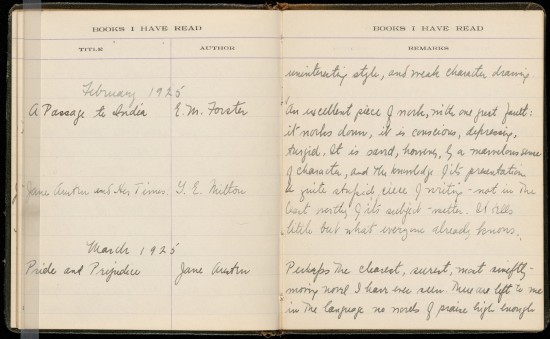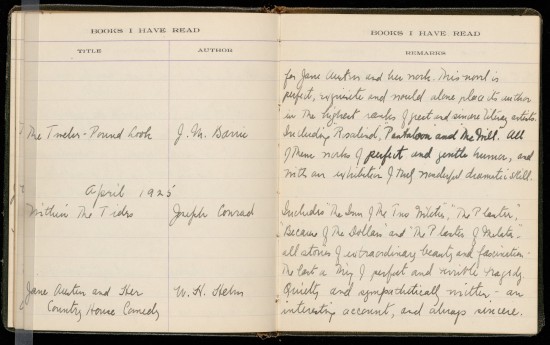We are accustomed to thinking of Pride and Prejudice as Austen’s best beloved novel. Its top place in the global popular imagination was secured in 1940 by the MGM feature film starring Laurence Olivier and Greer Garson, which dominated visual renderings of Mr. Darcy and Elizabeth Bennet for years to come.1 Thanks to scholars of Austen’s publication and reception, we know quite a bit about how readers encountered Pride and Prejudice prior to its first cinematic adaptation. Janine Barchas has brought to light the many cheap editions of Austen available from the mid-nineteenth through twentieth centuries, while Devoney Looser has attended to Austen’s status among gentleman’s-club members, suffragettes, and others during the same decades, as well as to the appearance of her works in schoolbooks. Early critical commentary on Pride and Prejudice has been well summarized by Janet Todd, with fuller accounts available from B. C. Southam and Katie Halsey, among others.
Of what American readers in particular thought of Pride and Prejudice prior to 1940, however, little is widely known. The exception is the diametrically opposed views expressed by Mark Twain and his friend (and fellow novelist) William Dean Howells at the turn of the twentieth century.2 It is worth bearing in mind that Twain declared his gleeful disdain for Austen privately—in his diary, letters, and in conversation—while Howells publicly shared his love for Austen to a broad audience via magazine articles. While Howells’s emphatic praise for “Jane” is well remembered, few recall his 1900 commentary on Pride and Prejudice for the women’s magazine Harper’s Bazar (as the title was then spelled), which was illustrated by one of the leading commercial artists of the day. Equally overlooked today is the discerning critical commentary of Oscar Fay Adams, a contemporary of Howells’s who was acclaimed in the 1890s as the foremost American advocate for Austen. Private reading journals kept from the 1920s to the 1940s by Charles Beecher Hogan, an aspiring Austen scholar and collector, furnish valuable insight into how one knowledgeable, passionate reader viewed Austen’s novels, including Pride and Prejudice, from youth to middle age. Attention to these neglected sources enriches our understanding of the reception of Pride and Prejudice while also illuminating the crucial role Americans played in building Austen’s global readership and ensuring her legacy.
Because Adams, Howells, and Hogan wrote without academic jargon, moreover, today’s Austen fans will find their commentary not only accessible but highly engaging. In addition to quoting passages that are sure to prompt discussion, I introduce each author by posing a challenge based on his writings. These challenges can serve as conversation starters among JASNA members and as classroom exercises for secondary or undergraduate students. I conclude with an exhortation to all lovers of Austen to continue the work of Adams and Howells by reaching out encouragingly to first-time readers of Austen.
Oscar Fay Adams’s Chapters from Jane Austen: Presenting Pride and Prejudice to 1880s Americans
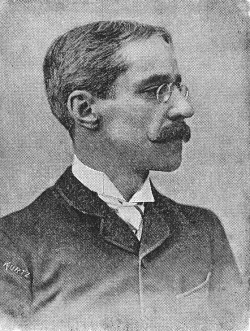
Portrait of Oscar Fay Adams (1890), from The Cosmopolitan. Author’s collection.
Imagine that you must convey the essence of Pride and Prejudice to first-time readers in just fifty pages. Your task is not to retell the story in abridged form. Rather, you are to select the most important chapters and link them together via the barest minimum of plot summary. You will supply an annotated list of major and minor characters plus whatever explanatory footnotes you deem necessary for the audience you have in mind. Which chapters would you include, and what terms or concepts in those chapters would you gloss? Which characters would you denote as major and which as minor? How would you pithily describe each one, and in what order would you introduce them?
This was the task that Oscar Fay Adams (1855–1919) faced when preparing Chapters from Jane Austen, published in 1889.3 In addition to comparing their own choices with Adams’s, students will find it thought-provoking to consider what in Austen’s writing remains easily accessible to readers of their own generation, and what requires elucidation.
 |
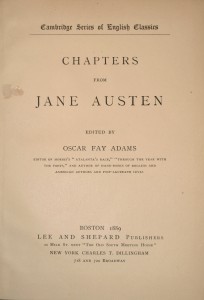 |
|
Two covers and title page of Chapters from Jane Austen. Author’s collection. |
|
Adams placed Pride and Prejudice first in Chapters from Jane Austen because, based on the information available to him, he understood it to have been her earliest completed novel.4 Intriguingly, Adams’s list of “dramatis personæ” in Pride and Prejudice, unlike those he devised for the subsequent five novels, separates male and female characters, proceeding alphabetically (mostly) through each group of names. Thus Mr. Bennet heads the list of men, followed by Mr. Bingley, Rev. Mr. Collins (as Adams renders his name), and Mr. Darcy, all the way to Mr. Wickham. These five Adams designates in boldface type as “principal characters”; italics for Colonel Fitzwilliam, Colonel Forster, Mr. Gardiner, Mr. Hurst, and Sir William Lucas indicate their status as supporting characters. Among the women, Adams singles out Mrs. Bennet, Jane, Elizabeth, Lydia, Miss Bingley, Miss Darcy, Lady Catherine, and Charlotte as primary, while his capacious list of secondary women comprises Mary, Kitty, Miss de Bourgh, Mrs. Gardiner, Mrs. Hurst, Lady Lucas, Mrs. Jenkinson (whom Adams admits is “an unimportant character” [43]), Mrs. Phillips, and Mrs. Reynolds.
Adams’s straightforward, informative character descriptions would be useful to anyone struggling to keep track of the cast list of Pride and Prejudice. That group certainly includes my college students, who have been known to complain about how names they must remember and how many of those begin with “B.” Teachers and students should be warned, however, that Adams includes many plot spoilers, as the following representative examples make plain. He sums up Mr. Darcy as “[t]he hero of the story. A young man of twenty-eight, stiff and reserved in manner, and with an exalted idea of his own importance as a gentleman of good family. He is nephew to Lady Catherine, and his family estate is situated at Pemberley, in Derbyshire” (41). Adams grants Elizabeth the longest introduction:
Second daughter of the Bennets and the heroine of the tale. A girl of much natural intelligence, quick wit, and beauty. She becomes prejudiced against Darcy on her first meeting with him, and will not see anything in him to admire. On his conquering his pride so far as to ask her to marry him, she declines his offer. Becoming convinced that her prejudices against him are baseless, she learns to admire and finally to love him, and on his second proposal she accepts him. (42)
Note that Adams highlights Elizabeth’s intellect before acknowledging her beauty: a priority that he shares with few characters in the novel aside from Mr. Bennet and, perhaps, Jane. For both Mr. Bennet and Mrs. Bennet, Adams quotes the narrator’s establishing descriptions at the end of chapter one: “so odd a mixture . . .” and “a woman of mean understanding . . . ,” respectively (41, 42). Otherwise, Adams paraphrases rather than quoting. Thus, he sums up Mr. Collins as a “young clergyman with very slender mental capacities, but of absurdly pompous and solemn manners,” while Lady Catherine is a “narrow-minded, supercilious woman of quality” (41, 43). Charlotte “marries Mr. Collins, and is thereby condemned for the rest of her life to endure his stupidity and Lady Catherine’s insolent patronage” (43).
Little, if anything, in these descriptions is apt to raise an objection from those already acquainted with Pride and Prejudice. Adams’s choice of chapters, by contrast, might well inspire lively discussion, as, between the first and last chapters of the novel—which we would all certainly agree ought to be included—he must ruthlessly excise so much. Adams gives his readers Darcy’s first proposal but neither the Meryton assembly at which Darcy and Elizabeth first meet nor his letter following her rejection of him. While Mr. Collins’s proposal is present, as is Lady Catherine’s interrogation of Elizabeth at Rosings, very little appears of the free indirect discourse with which Austen illuminates Elizabeth’s thoughts, and none of her confidential conversations with Jane and Charlotte.5 Altogether, Adams’s group of chapters emphasizes dialogue over narration and the comic over the serious, decisions that arguably make sense for his project of interesting new readers in Austen.
Adams’s editorial hand, while light, shows his care in thinking through what would likely puzzle his contemporaries. Concerning the heading of Mr. Collins’s initial letter to Mr. Bennet—“Hunsford, near Westerham, Kent”—Adams notes that Westerham is “a market town twenty-five miles southeast of London” (51): a real place, in other words, as American readers could not be expected to know. Of Mr. Collins’s confident declaration to Mr. Bennet that he shall “probably trespass on your hospitality till the Saturday se’nnight,” Adams observes: “Ninety years ago this useful word had not become such a stranger to conversation and literature as at present. Its complement, fortnight, a contraction of fourteen night, as se’nnight is of seven night, shows, however, no signs of falling into disuse” (52). Adams anticipates too that his readers will not know who Fordyce was, how to play quadrille, or what Lady Catherine means by “a wilderness” (57, 60, 78).
In addition to these purely explanatory footnotes, Adams occasionally weighs in on critical debates, usually in relation to the excerpts from reviews, articles, and essays that he presents in his introduction to the volume, and which he lists in a concluding bibliography.6 “Lady Catherine’s insolence of manner has been considered by some critics as much exaggerated,” he avers; “but it must be borne in mind that she was a narrow-minded person with an overweening sense of her own importance, and that she was in the company of people whom she regarded as immeasurably her inferiors in social position. To the arrogance and impertinence of such a woman under these circumstances the endurance of her victims could be the only limit” (78–79). Concerning the paucity of Austen’s references to contemporary events, Adams contends that “[l]iving as she did at a time when affairs of great national importance were of frequent occurrence, it is hardly likely that she could have remained indifferent to them; but she evidently did not look upon them as coming within the province of a writer of fiction” (88).
What Adams himself thinks of Austen’s artistry, and of Pride and Prejudice, comes across most clearly in his introduction. Contrasting her with her once-popular contemporaries Frances Burney, Ann Radcliffe, Elizabeth Inchbald, and Jane Porter, Adams praises Austen for knowing, “as hardly any novelist has known before or since, just where to draw the line between enough and too much” (3). Adams defends Austen, moreover, against the implication that her limited life experience impoverishes her range of reference: “to an acute, observing mind like hers these materials were ample for her purpose. Certainly whoever reads Pride and Prejudice is conscious of no lack in this respect” (5).
Finally, Adams offers the following original interpretation of Pride and Prejudice based on his own attentive reading of Austen’s letters, a portion of which had been published just a few years earlier, in 1884, by her great-nephew Edward, Lord Brabourne. “My own opinion,” he ventures,
is that in Elizabeth Bennet . . . she unconsciously drew her own portrait. There is to my thinking the same quality of wit, united to good sense, in these familiar letters to her sister, which is so marked a feature of Elizabeth Bennet’s character. In the heroine of Pride and Prejudice she gave the same full play to her powers in this particular direction that her letters evince; and I like to think that in this delightful heroine we have in some sense the mental portrait, none the less faithful because unconsciously drawn, of one of the sweetest of women as well as one of the greatest writers of fiction in our English-speaking world. (8)
Many subsequent readers have felt much the same. In his biography The Story of Jane Austen’s Life, first published in 1891 with a new, illustrated edition in 1897, Adams was to develop fully his unconventional depiction of Austen as a purposeful artist who found considerable joy in literary composition and in her family relationships.7
William Dean Howells’s “Jane Austen’s Elizabeth Bennet” (1900): Astute acclaim for the heroine and for her author
You have been commissioned by a major women’s magazine to write a series of articles about the novel in English, under the overall title “Heroines of Nineteenth-Century Fiction.” You can expect that your audience will know your name and trust your judgment, because you are a bestselling novelist and a prominent public intellectual, although you lack a university degree, much less a doctorate. Your articles, illustrated by prominent artists, will appear alongside light fiction, recipes, and fashion news. What will you say about Pride and Prejudice, and which passages will you quote, to grab your readers’ attention and inspire them to pick up a copy of the novel and read it for themselves? If you are posing these questions to students, consider having them imagine any popular content venue, perhaps a YouTube channel or Substack newsletter, the audience for which will have varying levels of familiarity with and interest in English literature. You could encourage students as well to think about how they would illustrate Austen’s characters in a way that speaks to twenty-first-century audiences—or actually to create such images.
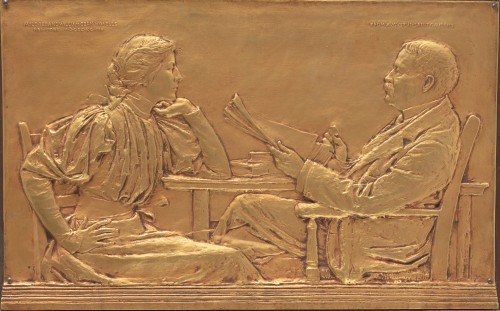
Mildred and William Dean Howells, by Augustus Saint-Gaudens (1898).
National Portrait Gallery USA;
transfer from the National Gallery of Art; gift of Mildred Howells (1949).
Like Oscar Fay Adams, William Dean Howells (1837–1920) began his Austen essays with Pride and Prejudice because he believed that it “was written first” (1: 39).8 This placement also suited Howells’s judgment that Pride and Prejudice is the greatest of Austen’s novels. He hastens to explain that he considers “all Jane Austen’s books [to be] extraordinary,” and that the other five “are each a masterpiece, inferior only to ‘Pride and Prejudice’” (1: 39). Like Adams, Howells puts Austen in the context of her fellow women writers, principally Frances Burney and Maria Edgeworth, the subjects of his two previous “Heroines of Nineteenth-Century Fiction” articles. Howells, however, decisively elevates Austen above these contemporaries: she, he declares, was “the greatest of the gifted women” (1: 38). And, what’s more, Howells proclaims Austen to have outdone “all other novelists,” regardless of gender, in determining “the character and behavior of Anglo-Saxon fiction.” In other words, he credits her with having invented the English novel, much as Kathryn Sutherland has influentially argued in our century. Though Howells subsequently refers to Austen’s readers as a “cult” of “adorers” (1: 49), at the outset he stresses the sheer excellence of her novels: “Jane Austen was indeed so fine an artist, that we are still only beginning to realize how fine she was” (1: 38). Only after establishing her place in the literary canon does Howells enumerate the qualities that readers appreciate in Austen’s fiction: “its lovely humor, its delicate satire, its good sense, its kindness, its truth to nature, . . . its form” (1: 38).
In Pride and Prejudice, Howells singles out for admiration Austen’s handling of the evolving relationship between Elizabeth—“beautiful, clever, and cultivated”—and Darcy, “handsome, high-principled, [and] excessively proud” (1: 41). (Even-handedly, Howells begins with looks for each one.) This “affair,” he exclaims, is “one of the most daring in fiction,” and he calls Darcy’s letter following his unsuccessful proposal “a great stroke of originality” (1: 43). Yet Howells does not quote that letter, or indeed any scene between Elizabeth and Darcy, except for the intimate conversation that follows their engagement. In a departure from his usual critical acuity, Howells characterizes that dialogue as “deliciously lover-like,” extolling it for showing Elizabeth, “who is apt to seem at other times a little too sarcastic, a little too ironical, [as] here sweetly and dearly and wisely herself” (1: 43). The accompanying illustration is even sappier: having clearly never read the original passage, which takes place outdoors, Arthur I. Keller seats the characters together on a sofa. Elizabeth simpers towards Darcy, who, sitting with his legs crossed, manages to look neither tall nor handsome. At least their clothing bears a resemblance to Regency fashion, as is not true of all the illustrations to the “Heroines” essays.9

By Arthur Keller, in Heroines of Nineteenth-Century Fiction. Author’s collection.
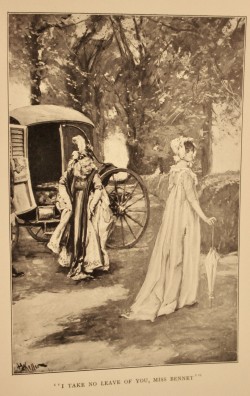
By Arthur Keller, in Heroines of Nineteenth-Century Fiction. Author’s collection.
(Click here to see a larger version.)
Howells takes a more balanced view of Elizabeth when discussing the only other passage he quotes at length: the dialogue between her and Lady Catherine at Longbourn concerning the rumor of her engagement to Darcy. (Chronologically, of course, this occasion precedes the one Howells has just treated.) Calling attention to both the comedy and drama of this scene, Howells further identifies it as “express[ing] the beginning of that revolt against aristocratic pretension characteristic of the best English fiction of our century” (1: 45).10 Drawing a different kind of connection between Elizabeth and Austen than did Adams, Howells speculates too that the author may have been inspired by a similar encounter in her own life: “one feels that Elizabeth Bennet is speaking Jane Austen’s mind, and perhaps avenging her for patronage and impertinence otherwise suffered in silence” (1: 45). While Howells briefly criticizes Elizabeth for indulging in “sauce” (1: 47)—i.e., being too saucy—this quality does not outweigh, in his mind, her “personal dignity,” which shows her to be “much more a lady than her ladyship” (1: 48). Altogether, he asserts, Elizabeth’s “temperament and character [are] cool, humorous, intelligent and just: a combination of attributes which renders [her] one of the most admirable and attractive girls in the world of fiction” (1: 48). None of these qualities is discernible in Keller’s accompanying illustration, in which a troll-faced Lady Catherine glowers at a prim-lipped, passive-looking Elizabeth.
An exclusive focus on Pride and Prejudice does not do justice to the breadth of insight in Howells’s “Heroines” essays on Austen, all of which are worth rediscovering, as are the illustrations Rosina Sherwood created for Northanger Abbey and Persuasion. Of lesser interest, except to completists, is the introduction Howells wrote to a 1918 student edition of Pride and Prejudice, in which he reflects on a final, and not wholly satisfying, rereading of this novel.11
Charles Beecher Hogan: Private responses, carefully preserved
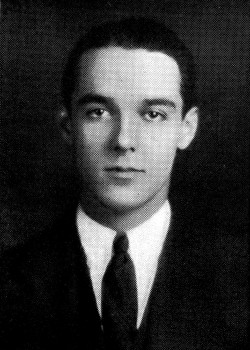
Charles Beecher Hogan, in History of the Class of 1928, Yale College. Author’s collection.
You are an earnest, ambitious student of literature, a senior at a prestigious prep school, heading to Yale. You write down a sentence or two summing up your response to each of the books you read, from detective novels to literary classics, to textbooks and scholarly works. You keep up this practice for twenty years, as you move through college and graduate school, work as a librarian, get married, and teach English at Yale, while always collecting books on your favorite authors. What do you write about Pride and Prejudice when you’re in your teens? Your twenties? Your thirties? At the end of your life, when you’re organizing your book collections for donation to Yale, do you include your long-ago reading journals? Why or why not?
Charles Beecher Hogan (1906–1983) donated to Yale four volumes of reading responses, written beginning in October 1923, when he was in his final year as a student at the Choate School in Connecticut. When I first visited Yale’s Beinecke Library to research Hogan’s collecting, the skeletal finding aid (description of contents) of Hogan’s Austen archives had yet to be digitized. Thus the existence of these volumes came as a complete, and exhilarating, surprise.12
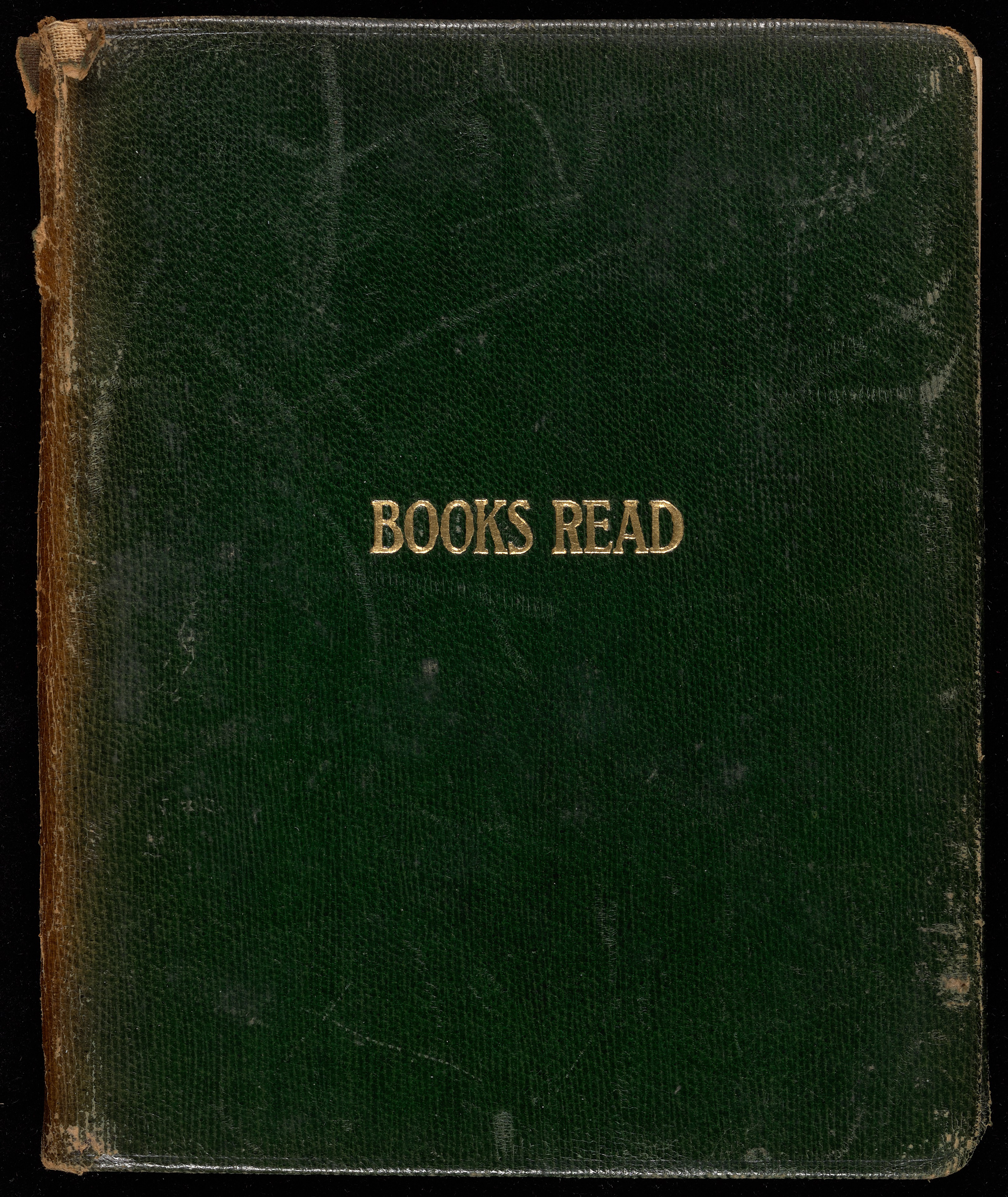 |
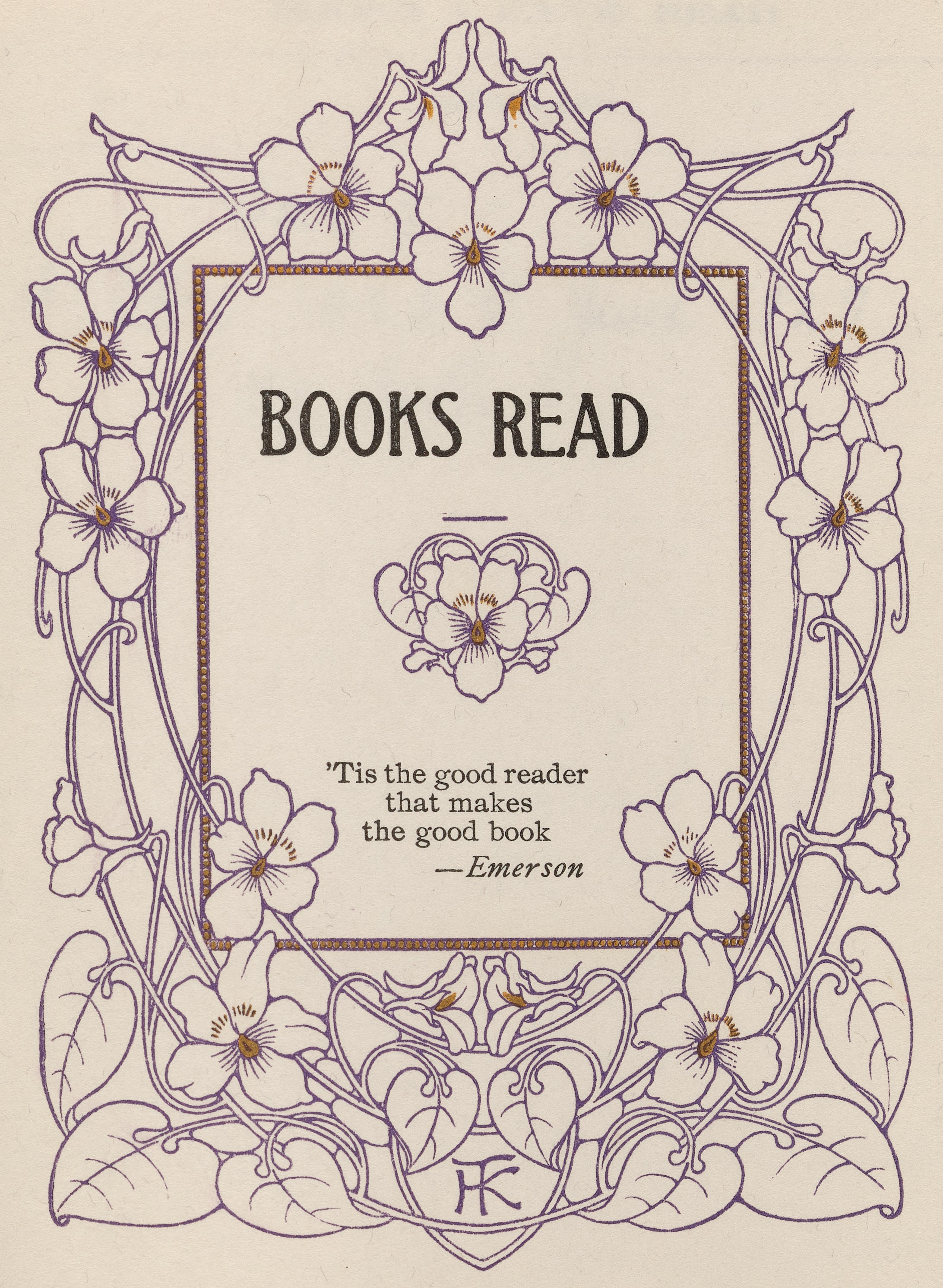 |
|
| Cover and title page of Hogan’s first reading journal, which he titled “Book I.” (Charles Beecher Hogan Papers Relating to Jane Austen. General Collection, Beinecke Rare Book and Manuscript Library, Yale University). | ||
The young Hogan’s boundless enthusiasm for Austen is apparent from his earliest entries in the commercially printed volume, Books Read, that he titled “Book I.” “Jane Austen is my favorite novelist, simply because she writes such exquisitely perfect and lovely books,” he noted in March 1924, following his rapturous assessment of Mansfield Park as a “perfect work of art—I wish it would go on forever.”13 His earliest response to Persuasion, in July 1924, rates it as “[o]ne of the most complete examples of technical perfection I have ever read. Second only to ‘Emma’—the masterpiece of this wonderful woman.” In March 1925, during his freshman year studying English at Yale, he judged Pride and Prejudice to be “[p]erhaps the clearest, surest, most swiftly-moving novel I have ever seen. There are left to me in the language no words of praise high enough for Jane Austen and her work. This novel is perfect, exquisite and would alone place its author in the ranks of great and sincere literary artists.”
Above: Hogan’s March 1925 entry on Pride and Prejudice (Charles Beecher Hogan Papers Relating to Jane Austen. General Collection, Beinecke Rare Book and Manuscript Library, Yale University).
By the time Hogan returned to Pride and Prejudice in May 1931, he had finished his undergraduate degree plus a year of study at the University of Cambridge. He had also added to his Austen collection the treasures for which he is remembered: the two topaz cross pendants set in gold and accompanying gold chain that were bought for Jane and Cassandra Austen by their younger brother Charles. The full story of when and how Hogan acquired these incomparable relics, together with the letter in which Jane excitedly apprised her sister of the gifts, I tell for the first time in A New Jane Austen, drawing on archival material in Hogan’s collection at the Beinecke as well as at Jane Austen’s House.14 Suffice it to say here that Hogan aspired to become the leading American Austen scholar of his generation, and he collected in order to support that ambition. After publishing an article on Austen and earning a master’s degree in English at Yale, however, Hogan did not pursue a Ph.D., and his research subsequently centered on eighteenth-century stage performances in London. In 1933, he married a very wealthy woman, Carolyn Crosby, known as “CC,” an accomplished pianist, to whom he presented the topaz crosses as a wedding gift.15 Having apprised the Jane Austen Society of his plans to bequeath the jewelry, Hogan astonished its members at the conclusion of his plenary address to the Society in July 1974 by pulling the crosses out of his pocket and announcing that he was donating them on the spot. In 1979, Hogan accepted an invitation from the founders of JASNA to become a “patron,” thereby adding his name to a distinguished list of academics lending luster to the new organization.
How much critical acumen Hogan gained from his formal study of English literature is apparent from his second, May 1931 entry on Pride and Prejudice. “I was very forcibly struck—more so than ever before—by Jane Austen’s very remarkable knowledge of the value of rhythm and sound in style. It is as elusive as so much else that is good in her books, because she first eliminated and then concentrated. She writes with her eyes fixed just exactly far enough in front of what she’s doing.” Evidently, Hogan remains just as impressed by Pride and Prejudice as he was when younger, with the difference that he can now express his praise with greater precision.
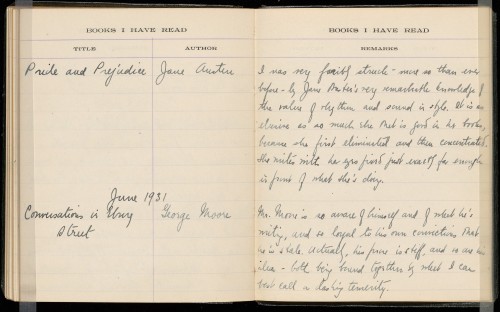
Hogan’s May 1931 entry on Pride and Prejudice (Charles Beecher Hogan Papers Relating to Jane Austen. General Collection, Beinecke Rare Book and Manuscript Library, Yale University).
(Click here to see a larger version.)
Hogan did not, however, retain this high estimation of Pride and Prejudice. In his final response to this novel, written in October 1941, he declared, “every time I read this book I am more aware of the truth of its author’s remark that it is ‘too light, and bright, and sparkling; it wants shade.’ So it does, and particularly shading between the scenes—which follow one another much too abruptly. But for the sparkle and light within each scene, no novel ever written is its equal.”16 Hogan’s objection to how “abruptly” Austen makes scene transitions stands in strong contrast to his initial appreciation for Pride and Prejudice as “the clearest, surest, most swiftly-moving novel I have ever seen.” The marked changes in Hogan’s responses from decade to decade demonstrate the value of writing down one’s fresh impressions after each re-reading. Today’s readers, of course, have the choice of whether to share their responses with fellow fans through social media.
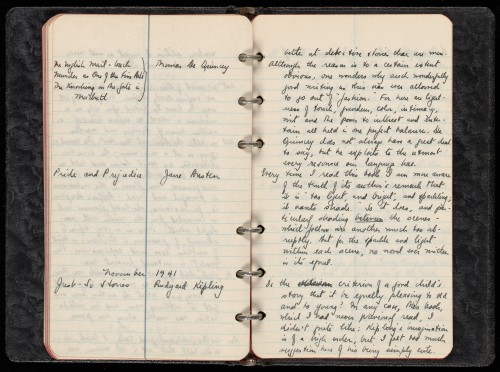
Hogan’s October 1941 entry on Pride and Prejudice (Charles Beecher Hogan Papers Relating to Jane Austen. General Collection, Beinecke Rare Book and Manuscript Library, Yale University).
(Click here to see a larger version.)
These glimpses of Hogan’s reading journals give but a taste of this extraordinary record of his reactions over time to Austen’s fiction, including her teenage writings and unfinished manuscripts, as well as to scholarship about and creative responses to her major novels. Among the more than eight hundred total entries in Hogan’s four volumes are many unrelated to Austen that will be of interest to historians and scholars of reading. It is to be hoped that the Beinecke continues to digitize these sources in their entirety and make them publicly available, as it has recently done for Hogan’s first Books Read volume.17
A concluding appeal
Adams’s and Howells’s efforts to interest new audiences in Austen’s novels invite us all to reflect on how we can continue that vital endeavor. As Austen’s 250th birthday approaches, in 2025, we can each expect to have many opportunities to introduce our favorite author to first-time readers.18 Thus I encourage you to think about, and discuss with fellow Janeites, how you would choose to do so. Would you recommend starting with Pride and Prejudice? If so, what would you say to help someone understand and enjoy it? Think too about how you would describe Austen’s genius—the topic of JASNA’s upcoming 2025 AGM—to someone unfamiliar with her fiction. Perhaps, too, Hogan’s reading journals will inspire you to keep track of your own responses as you reread Austen and to consider how your appreciation has evolved.
NOTES
1For the influence of Olivier and Garson on covers of Austen editions worldwide, see Sullivan (195) and Barchas (187). The Jane Austen Collection formed by Alberta H. Burke and bequeathed to Goucher College contains more examples. In her scrapbooks, furthermore, Burke preserved cartoons and other ephemera responding to the 1940 film.
2See Southam (202–04, 232–33); Halsey (186–87); and Todd (140–41). My brief introduction here to Howells, Adams, and Hogan through the lens of Pride and Prejudice complements my concise overview in “The Artist and the Austen Collector” of the Austen archive built by the twentieth-century American Alberta H. Burke, with crucial contributions from her English friend Averil Hassall. For in-depth accounts of all these advocates’ work, see A New Jane Austen.
3Long out of print, and in the collections of only a handful of libraries worldwide, Chapters from Jane Austen is available on GoogleBooks and HathiTrust.
4Adams sums up the compositional history of Pride and Prejudice as follows: “begun at Steventon, October 1786; completed, August 1797; published, 1813” (39). Sense and Sensibility follows next in Chapters from Jane Austen, with the notation that it was “prepared for the press at Chawton in 1799” (91): evidently, Adams understood Rev. George Austen’s famously unsuccessful 1799 query letter to the London publisher Thomas Cadell as pertaining to Sense and Sensibility rather than, as is often assumed today, Pride and Prejudice. Johnston points out the indeterminacy of this letter and includes a facsimile of it (78–79).
5Adams numbers the chapters of Austen’s novels according to the 1883 Steventon edition, which he takes as an authoritative text (vi). As he explains, the Steventon edition divides Pride and Prejudice into two volumes, unlike the continuous chapter numbering of American editions (44 n. 1). Converted to the three-volume format familiar to us, the chapters selected by Adams are volume 1, chapters 1–2, 13–14, and 19–20; volume 2, chapter 11; and volume 3, chapters 14 and 19.
6In A New Jane Austen, I argue that Adams’s inclusion of critical excerpts and a bibliography, together with his concern to provide an authoritative text and his editorial footnotes, qualify Chapters from Jane Austen as the first critical edition of Austen’s novels (17–24).
7For my contention that Adams’s The Story of Jane Austen’s Life deserves recognition as the first critical biography of Austen, as well as my analysis of how he counters prevailing myths of Austen as a loveless spinster unconcerned with professionalism, see A New Jane Austen (24–39).
8Howells and Adams were acquainted through Boston literary circles, though it is unknown whether Howells read Chapters from Jane Austen. Howells’s “Heroines of Nineteenth-Century Fiction” essays were published in two volumes in 1901 as Heroines of Fiction. Because a digital facsimile of Heroines of Fiction is freely available on HathiTrust, I will cite that publication rather than the Harper’s Bazar issue, which is accessible only through ProQuest.
9Illustrators’ names are listed in the captions in Harper’s Bazar; the title page of Heroines of Fiction cites only “illustrations by H. C. Christy, A. I. Keller, and others.” For a reproduction and analysis of the portrait of Austen by Keller that accompanies “Jane Austen’s Elizabeth Bennet,” see A New Jane Austen (97–98); for analysis of illustrations to Howells’s discussions of Austen’s other novels, see A New Jane Austen (92–96).
10I discuss the “revolutionary” nature of Austen’s fiction identified by Howells in A New Jane Austen (99).
11See A New Jane Austen (107–10).
12The finding aid for the Charles Beecher Hogan papers relating to Jane Austen is now available at https://archives.yale.edu/repositories/11/resources/12864.
13Charles Beecher Hogan, Books Read volumes, Charles Beecher Hogan papers relating to Jane Austen, GEN MSS 413/1/18, 18a, 18c, Beinecke Rare Book and Manuscript Library, Yale University, New Haven, Connecticut. Subsequent quotations from Hogan’s reading journals are from the same source.
14See A New Jane Austen, 133–36. For images of the topaz crosses and gold chain, see https://janeaustens.house/object/topaz-crosses/.
15See A New Jane Austen (144–47).
16On Hogan’s diminished appreciation in later years for Sense and Sensibility and Mansfield Park, in contrast to his consistently high estimation of Emma, see A New Jane Austen (147–50).
17See https://archives.yale.edu/repositories/11/archival_objects/3498951.
18In the concluding chapter of A New Jane Austen, “Jane Austen Anew,” I offer additional suggestions and strategies for helping new readers connect with and appreciate Austen’s writings.
